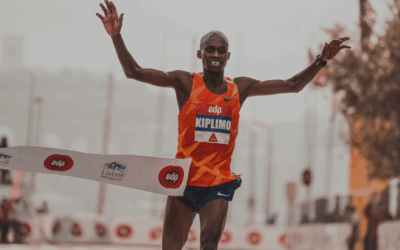Imagine this: It’s a new year. You decide that you’re going to run another marathon this Spring and set yourself the goal of qualifying for Boston… a sub-3 hour finishing time. You have two marathons under your belt, the most recent being a finishing time of 3:45.
You train hard all throughout the winter. You’re feeling good (minus that nagging pain in your hip from doing too much too soon…). You’re feeling fast!
Spring comes around. It’s race day. You lace up your shoes, show up at the start line, give it your all, and… finish with a time of 3:15. As you cross that finish line, you feel a sense of disappointment and frustration. You feel like all your hard work was for nothing. Although PRing your marathon time by a whole 30 minutes is an incredible accomplishment, you don’t see it this way. You just see the 15 minutes that you missed your goal by.
This is, unfortunately, a pretty common phenomenon in endurance sport: Set an unrealistic, arbitrary goal and then beat yourself up over not reaching it. Nobody wants to be in this position.
We often think of goal setting as a really simple process – something we can come up with in a matter of minutes. In reality, good goal setting can be tricky! It involves a lot of reflection, long-term planning, and the ability to break down your bigger goals into smaller chunks. But, it’s clear that taking the time at the beginning of the year to sit down and intentionally set good goals will allow you to:
- Have more fun
- Make more progress in performance and better understand that progress
- Maintain motivation in the long-term
- Stay focused on what really matters to you
With all that said, how do we go about setting good goals for the year to achieve success? What does this process look like? How do we set ourselves up for success?
Most people start by picking their races. Believe it or not… this is actually one of the last steps you should be taking!
Steps to Take in your Goal Setting Process For Effective Goal Setting
1. Start with a reflection on the previous year
Take the time to answer questions like:
- What are 3 big wins you had last year?
- What are 3 lessons you learned?
- What did you enjoy about your training and racing? What did you not enjoy?
- What was your biggest strength and your biggest weakness last year?
- How has last year made you a better athlete?
Physically write these out!
2. Plan long-term (2-5 years)
Short-term goals consist of weekly, monthly, and even yearly goals. When we look more long-term, we want to ask ourselves: Where do I want to be in 5 years?
Long-term planning gives your year-to-year training a much deeper purpose. It acts as the compass, giving you a sense of which direction to take steps towards. With a solid long-term goal put in place, we are able to stay much more focused, motivated, and disciplined in the short-term. Progress in endurance sport takes TIME and thinking more long-term can allow us to recognize progress over a wider time-span. PBs won’t come along every season – especially if you’re a more experienced athlete – BUT if we can take small steps in the right direction each year, you’ll be surprised by how much you’re able to accomplish in 5 years.
3. List what you want to achieve this year
Think about: What is driving you this year? Why are you training? Go deep into your “Why” here and you won’t regret it. Your yearly goal(s) should align with your long-term (2-5 year) plan. This is also the perfect time to think about what obstacles you need to overcome in order to achieve this. Identify your weaknesses so you can tackle them and identify your strengths so that you can maintain or improve upon them.
From here, we can break up our yearly goal into quarterly season goals, 1-2 priorities for each quarter, and specific action steps we can take to tackle those priorities. It’s like trying to finish an entire cake by yourself: one piece at a time, one bite at a time, and not all at once.
4. Pick your events
Events set the dates in your calendar to anchor your training. Without specific events, it can be difficult to come up with your yearly training plan.
Importantly, these do not need to be structured races. This could be something like picking a bucket list route to complete or a Strava Crown to conquer. Ultimately, the events you choose just need to: A) Align with your main goal for the year, and B) Make you feel excited to achieve them.
In terms of more structured racing, we can break down races into 3 different types:
A-Races
These are your top priority races – the ones that align most closely with your yearly goal and hold a deeper meaning for you. Typically, we would look at picking 1-2 of these and spacing them apart by at least 3 months. When choosing your A-races, ensure that they’re giving you the best chance at success and you’re getting enough rest and recovery prior to competing. The name of the game with A-races is performance (whatever that looks like to you this year!).
B-Race
These are hard-effort races that aim to support your A-races. B-races are great chances to test fitness and gain race experience. Racing is a skill and, the more we practice it, the better we get. A B-race can give you a chance to trial race day tactics and nutrition when the stakes are much lower. Typically, we would look at picking 1-2 of these per year and ensure that they aren’t scheduled too close to our A-race.
C-Races
These races are your just for fun, participate in the community, social races. You can think of a C-race as a catered long run… a training run in a race setting! It’s really important that we check our egos at the door during these events. These races definitely aren’t for everybody and not everyone will choose to include this type of race in their yearly plan. This is O-K!
Types of Goals
There are two primary types of goals: Outcome goals and Process (Action) goals.
Examples of outcome goals include:
- Run a sub-20 minute 5K
- Win a local triathlon
- Qualify for Boston
- Increase your threshold power to 250W
Examples of action goals include:
- Run 5 days/week
- Strength train 2x/week
- Fuel with 200 calories/hour for training runs over 1.5h
- Keep a detailed training log
In sport, the outcome of an event, game, or match is so often out of our control. We can’t control the conditions on race day. We can’t control how other competitors perform. However, the actions we take leading up to and during a competition are entirely within our control. Action goals are where the magic truly happens. If we can set good action goals and follow through with steps to ensure we’re achieving them, the outcome will so often sort itself out!
How do you know if your goals are achievable?
The million dollar question: Can I achieve my goal? Is it possible?
Most of the time, we pick goals but have no idea how they relate to our current abilities. Performing a gap analysis can help us to solve this problem.
A gap analysis is simply looking at what we currently have (Point A) relative to what we need (Point B) in order to accomplish our performance goals. In sport, the way we assess this gap is through testing. We can do this a number of different ways, but some suggestions include:
- Looking at your most recent race time
- Performing a time trial (5K, 10K, 30 minutes)
- Testing how long you can maintain your goal pace/speed
Importantly: It’s rarely a case of whether or not you can achieve your goal, but rather a case of how long it will take. Knowing what your current skill and fitness level is relative to where you want to be can give you a better indication as to whether your goal should be a short-term (1 year or less) goal or a long-term (2+ years) goal.
As important competitions approach, we want to have most of our gaps mastered. This means that the best time to work on your particular gap(s) is as far away from your A-race as possible so that you can focus on simply maintaining these qualities in-season.
What happens if you fail?
As cliche as it might be, failure is an inevitable part of life. Failing to achieve the goals we set for ourselves is something that everyone will experience at some point. Understanding how to deal with failure is an important part of being an athlete (and a human being!).
It’s important to clearly define what “failure” and “success” mean to you ahead of time. For example, if you didn’t hit the race time that you wanted this year, but were successful in accomplishing all of the process goals you set out for yourself – do you consider this year a failure? Failure does not need to be black and white. We can find successes even in years where we fail to accomplish our yearly goal.
Failing to reach a goal does not mean that you, yourself are a failure. It doesn’t always mean that you didn’t work hard enough or do the right things. Sometimes, you just need more than one attempt at a goal and that is O-K! Failing is a great chance to reflect on what you can change in order to accomplish that goal in the future. Maybe you just need more time. Maybe you need to adjust your training or racing approach. Maybe the goal itself needs to be adjusted to be realistic within the timeline you set for yourself.
Having self-compassion in moments of failure is crucial. Imagine you have a friend who’s in your situation: They set themselves a goal for the year, came up with a plan, and ultimately failed to reach that goal. How would you react to them? What would you tell them? We should seek to treat ourselves the same way.
You’ve created your plan… What now?
We recommend physically putting your goals somewhere where you can see them on a daily basis. This can act to keep your compass pointed in the right direction and help with discipline on the hardest of training weeks. Telling your friends and family about your goals is also a great way to help with accountability through social support.
Ensure that you’re using regular intervals to check in and gauge progress to stay motivated. Always (re-)evaluate your gaps and adjust priorities and action plans as needed. We recommend doing this every 3 months or so. No plan should be set in stone!
Lastly, your goal setting plan can be a great tool to go over and refine with your coach. At Vital, we find it much easier to coach athletes and create training plans when their goals are more clearly outlined in the short- and long-term.
Hopefully this post gives you a little taste of what it takes to set yourself good goals this year. It’s not always an easy process, but it is always worth it. If you want help with training towards your goal for the year, we’re here to help.
Check out our Vital Endurance Coaching Plans.

More About The Author
Chantelle Ball, MKin, CSEP-CEP, CSCS
Chantelle Ball is a Clinical Exercise Physiologist and Strength & Conditioning Specialist with a Master’s in Kinesiology from the University of Calgary. With a diverse background in personal training, high-performance athlete testing, and strength training for neuromuscular conditions, she is passionate about the power of movement in enhancing physical and mental well-being. Chantelle currently works with complex endurance athletes managing conditions like stroke and multiple sclerosis, as well as those with specific strength and fitness goals.



